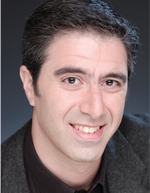ESRA Winner Talks About Statistics at Work, Play
Morteza Marzjarani
Alan Schwarz is a national correspondent for The New York Times whose series of more than 100 articles about concussions in sports was a finalist for the 2010 Pulitzer Prize for Public Service. He is the author of The Numbers Game: Baseball’s Lifelong Fascination with Statistics, with more than 25,000 copies sold. He is also a 1990 graduate of the University of Pennsylvania and holds a BA in mathematics. He was the 2013 winner of the Excellence in Statistical Reporting Award (ESRA).
When did you become interested in statistics? Who inspired you?
Robert Conti, my 9th- and 10th-grade math teacher at Scarsdale (NY) High School, was by far my favorite teacher ever—in part because he introduced me to basic probability. I loved figuring out how many poker hands had four clubs in them, six-person roundtables had two girls sitting next to each other, the whole bit. (I’m pretty sure I was the only kid in the school who actually liked hearing the word “urn”). This was not part of the official curriculum; Mr. Conti just tossed this stuff into the regular pre-calculus program for fun. I was hooked immediately.
That was my start. I adored reading Bill James, the baseball writer who pioneered the use of advanced metrics and statistical thought in the 1980s. (His field was not statistics per se, but the spirit was similar—using past performance of players to predict future performance.) Then, perhaps my junior year at the University of Pennsylvania, I read Innumeracy by John Allen Paulos. That little book was to me what Common Sense was to the Founding Fathers—it transformed how I saw the world and wanted to experience it.
What challenged you intellectually?
The most basic stuff—card hands, balls with replacement, waits on lines, that stuff—came so easy to me. My greatest academic accomplishment at Penn came when I woke up at 9:22 for my 8:30 Statistics 101 final exam. I scrambled to the classroom, got there at 9:28, had only 62 minutes rather than 120, and still got the best grade in the class.
I honestly didn’t go a whole lot past what ASA members would consider laughably basic, perhaps one level past Advanced Placement high school stuff. Discriminate function analysis and multidimensional scaling didn’t interest me much at all. I delighted in stuff like the Birthday Problem, truels (duels among three people), hot hands in sports, and other silliness. But that silliness has a tremendous amount of application to going through life with a mathematical mindset, especially as a journalist who tries to navigate seas of statistics used both dopily and deceptively. So I think what challenged me intellectually was not the statistics itself, which was basic, but exploring ways to use it in my work—in sports, in stories involving epidemiology, in scrutinizing methods and statements used in scientific studies that were just bogus.
What do you think about ESRA?
I’ve been privileged to win more than my share of honors over the past several years, but nothing comes close to ESRA. It validated how I’ve tried to navigate my career—with a respect for telling people what the data say and a responsibility to report what they don’t say, too. Ever since I was a kid, I wanted to be a high-school math teacher. I majored in mathematics at Penn so that I could become one. However, I wound up trying journalism—which meant I went from the most altruistic profession (teaching) to perhaps the most hedonistic (baseball writing). I carry around a good deal of residual guilt from that decision, but ESRA, to me, says that perhaps I’ve been a decent math teacher, just at a different blackboard.
What have you done since you won the award?
For the past two years I have done a major investigation into the overdiagnosis and overmedication of attention deficit hyperactivity disorder, mostly in young people—and while I work with real-life people and issues, numbers continue to be my primary divining rod. So many spurious arguments are debunked by mathematical common sense. One example: Child psychiatrists like to brush off concern about the issue by saying, “ADHD is both overdiagnosed and underdiagnosed.” What they mean, of course, is that there are too many kids being diagnosed, yes, but also lots of kids running around who deserve the diagnosis and aren’t getting it—so basically it’s a wash, no big deal. But hold on, fellas! That means that the kids who are getting diagnosed are the wrong ones! When you work out the numbers, you find out that at least half, perhaps more, of kids being diagnosed with ADHD actually don’t have it. I’ll spare the details on this next one, too, but I figured out that most epidemiological studies on ADHD have actually been using the wrong metric for decades, something that has obscured and impeded debate on the issue. This kind of garbage both drives me nuts—and drives me, period.
What are your future plans for using statistics in your journalism?
It’s hard to say that the future will be much different than most of my career. When the National Football League tried to downplay the discovery that four retired players had a really rare brain disease by saying it was “only four cases”—when it was not just four cases, but the first four players even examined—I knew from ridiculously basic probability that they were wrong. (As will everyone who just read that sentence.) When I see studies that claim that Ritalin and Adderall are not really cognitive enhancers because one-week trials show no benefit on average, I go to great lengths to prove that that’s just a stupid and reckless conclusion. There are a lot of preposterous—and often harmful—statements out there that are rooted in faulty mathematical thought. If I can detect them, correct them, and inform better debates about public health, then perhaps I chose the right blackboard after all.



















Congratulations to Alan!